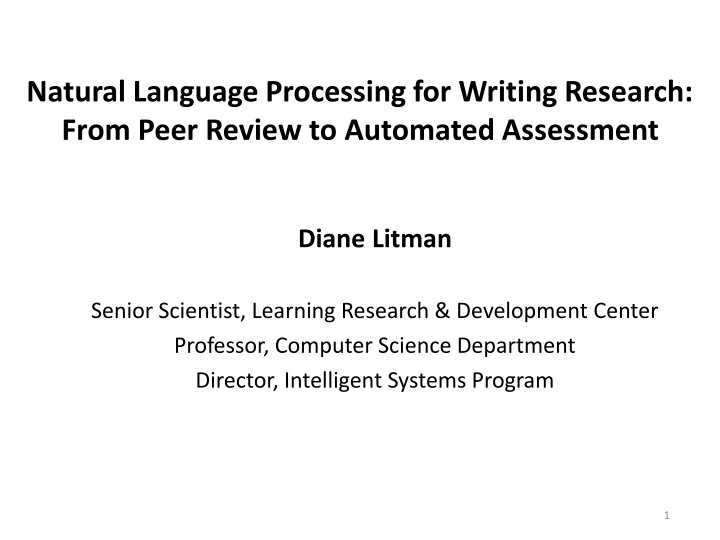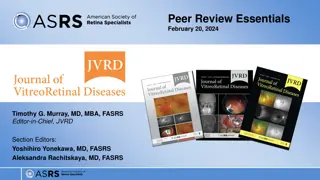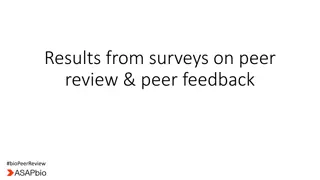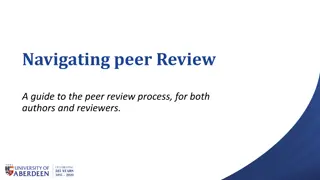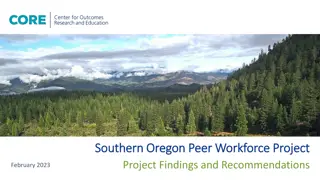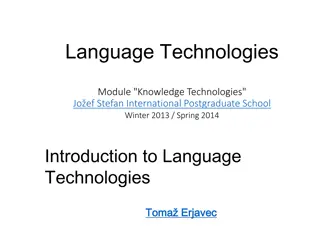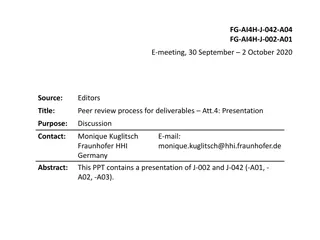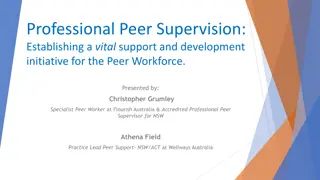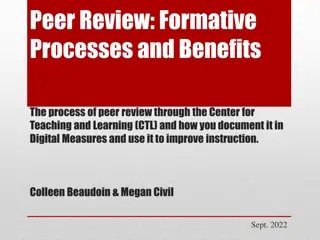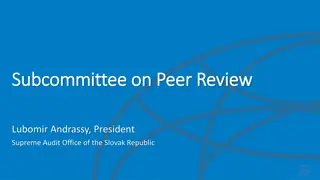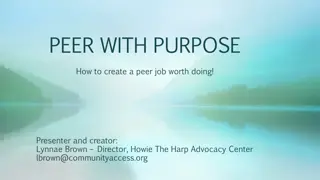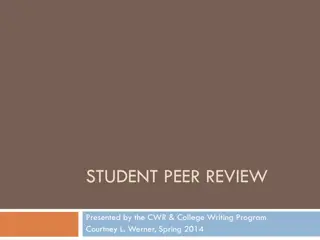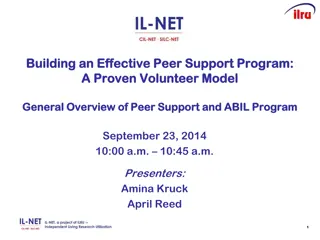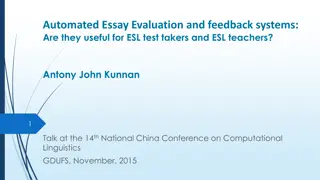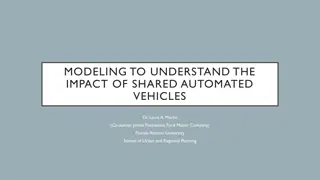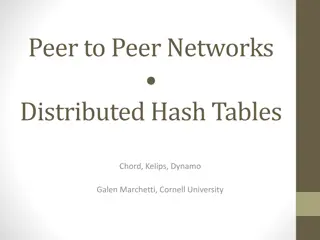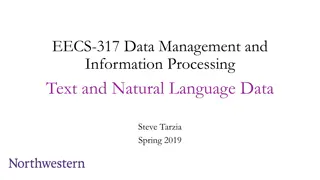Natural Language Processing for Writing Research: From Peer Review to Automated Assessment
Writing research presents a goldmine for NLP applications, from automating human coding to enhancing educational technology. Dive into two case studies exploring SWoRD and Argument Peer systems, with a focus on localization scaffolding and classroom evaluation using NLP attributes in real-time for undergraduate research methods.
Download Presentation

Please find below an Image/Link to download the presentation.
The content on the website is provided AS IS for your information and personal use only. It may not be sold, licensed, or shared on other websites without obtaining consent from the author.If you encounter any issues during the download, it is possible that the publisher has removed the file from their server.
You are allowed to download the files provided on this website for personal or commercial use, subject to the condition that they are used lawfully. All files are the property of their respective owners.
The content on the website is provided AS IS for your information and personal use only. It may not be sold, licensed, or shared on other websites without obtaining consent from the author.
E N D
Presentation Transcript
Natural Language Processing for Writing Research: From Peer Review to Automated Assessment Diane Litman Senior Scientist, Learning Research & Development Center Professor, Computer Science Department Director, Intelligent Systems Program 1
Writing Research is a Goldmine for NLP Can we automate human coding? New Educational Technology! Learning Science at Scale!
Two Case Studies SWoRD and Argument Peer w/ Kevin Ashley, Amanda Godley, Chris Schunn Response to Text Assessment w/ Rip Correnti, Lindsay Clare Matsumara 3
SWoRD: A web-based peer review system [Cho & Schunn, 2007] Authors submit papers (or diagrams) Peers submit reviews Problem: reviews are often not stated effectively Example: no localization Justification is sufficient but unclear in some parts. Our Approach: detect and scaffold Justification is sufficient but unclear in the section on African Americans
Localization Scaffolding Make sure that for every comment below, you explain where in the diagram it applies. For example, you can indicate where your comments apply by: (1) Specifying node(s) and/or arc(s) in the author's diagram to which your comment refers Your conflicting/supporting [node-type] is really solid! (2) Quoting the excerpt from the author's textual content of node and/or arc to which your comment refers For your [node-type] that talks about body chemistry and cortisol levels, you should clarify how that is related to politeness specifically. (3) Referring explicitly to the specific line of argumentation that your comment addresses Why does claim [node-ID] support the idea that people will be more polite in the evening? I don t know how to specify where in the diagram my comments apply. Could you show me some examples? My comments don t have the issue that you describe. Please submit comments. I ve revised my comments. Please check again.
A First Classroom Evaluation [Nguyen, Xiong & Litman, 2014] NLP extracts attributes from reviews in real-time Prediction models use attributes to detect localization Scaffolding if < 50% of comments predicted as localized Deployment in undergraduate Research Methods
Results: Can we Automate? Comment Level Diagram review Paper review Accuracy Kappa Accuracy Kappa Majority baseline 61.5% (not localized) 0 50.8% (localized) 0 Our models 81.7% 0.62 72.8% 0.46 Review Level Diagram review Paper review Total scaffoldings 173 51 Incorrectly triggered 1 0
Results: New Educational Technology Response to Scaffolding Reviewer response REVISE DISAGREE Diagram review 54 (48%) 59 (52%) Paper review 13 (30%) 30 (70%) Why are reviewers disagreeing? No correlation with true localization ratio (diagrams)
A Deeper Look: Revision Performance # and % of comments (diagram reviews) NOT Localized Localized 26 30.2% Localized Localized 26 30.2% NOT Localized NOT Localized 33 38.4% Localized NOT Localized 1 1.2% Comment localization is either improved or remains the same after scaffolding Localization revision continues after scaffolding is removed (see poster!)
A Deeper Look: Revision Performance # and % of comments (diagram reviews) NOT Localized Localized 26 30.2% Localized Localized 26 30.2% NOT Localized NOT Localized 33 38.4% Localized NOT Localized 1 1.2% Open questions Are reviewers improving localization quality? Interface issues, or rubric non-applicability?
Automatic Scoring of an Analytical Response-To-Text Assessment (RTA) [Rahimi, Litman, Correnti, Matsumura, Wang & Kisa, 2014] Long-term goal informative feedback for students and teachers Current work interpretable, NLP-based features that operationalize the Evidence rubric of RTA 11
Rubric-Derived Features Number of Pieces of Evidence (NPE) Topics and words defined based on the text and by experts Window-based algorithm Concentration (CON) High concentration: fewer than 3 sentences with topic words Specificity (SPC) Specific examples from different parts of the text Window-based algorithm Word Count (WOC) Temporary fallback feature 13
Essay with score of 4 on Evidence I was convinced that winning the fight of poverty is achievable in our lifetime. Many people couldn't afford medicine or bed nets to be treated for malaria . Many children had died from this dieseuse even though it could be treated easily. But now, bed nets are used in every sleeping site . And the medicine is free of charge. Another example is that the farmers' crops are dying because they could not afford the nessacary fertilizer and irrigation . But they are now, making progess. Farmers now have fertilizer and water to give to the crops. Also with seeds and the proper tools . Third, kids in Sauri were not well educated. Many families couldn't afford school . Even at school there was no lunch . Students were exhausted from each day of school. Now, school is free . Children excited to learn now can and they do have midday meals . Finally, Sauri is making great progress. If they keep it up that city will no longer be in poverty. Then the Millennium Village project can move on to help other countries in need. NPE CON WOC SPC 4 0 187 0 0 1 4 3 3 5 1
Results: Can we Automate? 0.7 0.6 0.5 Baseline1 (Na ve Bayes + Unigrams) 0.4 0.3 Baseline2 (LSA) 0.2 Random Forest + 4 Features 0.1 0 Accuracy (complete) Accuracy (subset) QW Kappa (complete) QW Kappa (subset) Proposedfeatures outperform both baselines
Results: Can we Automate? 0.7 0.6 0.5 Baseline1 (Na ve Bayes + Unigrams) 0.4 0.3 Baseline2 (LSA) 0.2 Random Forest + 4 Features 0.1 0 Accuracy (complete) Accuracy (subset) QW Kappa (complete) QW Kappa (subset) Absolute performance improves on less noisy data Complete: Complete dataset (n = 1569) Subset: Doubly-coded essays where raters agree (n=353) less training data, and only for our features
Other Results See poster Feature analysis Spelling correction Predictive utility generalizes to a second dataset 17
New NLP-Supported Directions Teacher dashboard for high school science writing LRDC grant -> (expected) NSF DRK-12 w/ Amanda Godley & Chris Schunn Peer review search and analytics in MOOCS Google award Student reflections in undergraduate STEM LRDC grant w/ Muhsin Menekse & Jingtao Wang
Thank You! Questions? Further Information http://www.cs.pitt.edu/~litman
Paper Review Localization Model [Xiong, Litman & Schunn, 2010]
Diagram Review Localization Model [Nguyen & Litman, 2013] Localization again correlates with feedback implementation [Lippmann et al., 2012] Pattern-based detection algorithm Numbered ontology type, e.g. citation 15 Textual component content, e.g. time of day hypothesis Unique component, e.g. the con-argument Connected component, e.g. support of second hypothesis Numerical regular expression, e.g. H1, #10 21
Results: Revision Performance Number (pct.) of comments of diagram reviews Scope=In Scope=Out Scope=No NOT Loc. Loc. 26 30.2% 7 87.5% 3 12.5% Loc. Loc. 26 30.2% 1 12.5% 16 66.7% NOT Loc. NOT Loc. 33 38.4% 0 0% 5 20.8% Loc. NOT Loc. 1 1.2% 0 0% 0 0% Comment localization is either improved or remains the same after scaffolding] Localization revision continues after scaffolding is removed Are reviewers improving localization quality, or performing other types of revisions? Interface issues, or rubric non-applicability?
Rubric for the Evidence dimension of RTA 1 2 3 4 Features one or no pieces of evidence Features at least 2 pieces of evidence Features at least 3 pieces of evidence Features at least 3 pieces of evidence Selects inappropriate or little evidence from the text; may have serious factual errors and omissions Selects some appropriate but general evidence from the text; may contain a factual error or omission Selects appropriate and concrete, specific evidence from the text Selects detailed, precise, and significant evidence from the text Demonstrates little or no development or use of selected evidence Demonstrates limited development or use of selected evidence Demonstrates use of selected details from the text to support key idea Demonstrates integral use of selected details from the text to support and extend key idea Summarize entire text or copies heavily from text Evidence provided may be listed in a sentence, not expanded upon Attempts to elaborate upon Evidence Evidence must be used to support key idea / inference(s)
Essay with score of 1 on Evidence Yes, because even though proverty is still going on now it does not mean that it can not be stop. Hannah thinks that proverty will end by 2015 but you never know. The world is going to increase more stores and schools. But if everyone really tries to end proverty I believe it can be done. Maybe starting with recycling and taking shorter showers, but no really short that you don't get clean. Then maybe if we make more money or earn it we can donate it to any charity in the world. Proverty is not on in Africa, it's practiclly every where! Even though Africa got better it didn't end proverty. Maybe they should make a law or something that says and declare that proverty needs to need. There's no specic date when it will end but it will. When it does I am going to be so proud, wheather I'm alive or not. NPE CON WOC SPC 0 1 166 0 0 0 0 0 1 1 0
Future RTA Directions New features and other scoring dimensions Full automation extraction of topics and words spelling correction Downstream applications for teachers and students 27
New NLP-Supported Directions Additional measures of peer review quality Solutions to problems Helpfulness Impact on writing quality Teacher dashboard (internal grant -> likely NSF DRK-12) Reviews Quality metrics (localization, solution, helpfulness) Topic-word analytics Review summarization Papers Revision behavior
Summing Up: Common Themes NLP for supporting writing research at scale Learning science Educational technology Many opportunities and challenges Characteristics of student writing Prior NLP software often trained on newspaper texts Model desiderata Beyond accuracy Interactions between NLP and Educational Technologies Robustness to noisy predictions Implicit feedback for lifelong computer learning 29
